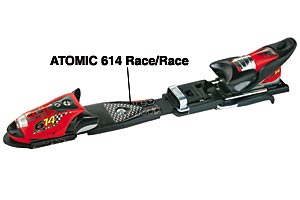Atomic Bindings 2001

Ask Atomic Race Manager Eduardo Guzman if there were any 1999-2000 World Cup races in which Atomic product did not finish on the medals podium, and he has to stop and think. “Yes. A few slaloms.”
But not many. The relentless, systematic way in which Atomic has improved its skis, developed a boot and reinvented its binding is exemplary. The 2000-2001 season brings small but significant changes¿ things such as cosmetics, tighter tolerances and performance plates that accept non-Atomic bindings. (Heretofore, if you bought an Atomic ski and plate, you were all but forced to buy their binding, too.)
Full Flex (fixed toe and floating heel) is Atomic’s trademark technology. It accommodates a boot as short as 260 mm, and one as long as 350 mm. A moveable AFD keeps release properties in the toe consistent, and Variozone allows the entire binding to be moved fore or aft.
614 Race
$355 RACER, AME
When you first stand on it, you think your poles have shrunk. That’s just the 24 mm of lift underfoot. The “soft/hard touch” heel pad is easy to depress when you step in, yet the brake, when released, has plenty of stopping power.
It’s hard to believe you can be so far removed from the snow and still have such sensitivity. This highest of Atomic setups is lively, yet provides enormous power and leverage on hard snow. In corn and slush you sense the “Free Flex” allowing the ski to arc roundly beneath you. The binding smooths the ride even in variable stop-and-go conditions.
All Race and Race/Race bindings have backward release in the toe, which lets you out in a rearward fall. You can move it to “locked,” which allows no release, as racers often do for competition.
614 Race/Race
$325 AME, AMC, FREERIDER
Despite the repetitive name, this is a step down, literally, from the 614 Race, with only 16.5 mm of lift. That’s a more reasonable height for recreational skiers, and low enough that racers can add a plate without violating the FIS limit. You can’t achieve such high edge angles, but this plate is more harmonious with the snow. The ski becomes more versatile and arguably quicker in short turns. The feel is still very lively, responsive, abundantly edgeable.
Both 614 bindings offer Variozone, which lets you be Goldilocks-fussy about fore/aft binding location. Move it to forward position for steeps, short turns and bumps, or back for speed. There are five positions. Find what’s “just right” for every hour, situation and snow type. There are even reports that racers on the super-dominant Austrian team use different fore/aft settings on the left and right foot to correct minor differences in leg length, hip flexibility, etc.
Centro 412
$260 PLAYER, AC
This is an excellent center-mounted binding, where both the toe and heel float. It is often used in demo fleets. The center pivot inhibits the same degree of ski bend as the Full Flex, rendering it less sensitive than other Atomic bindings. Still, the Centro has a very credible feel.